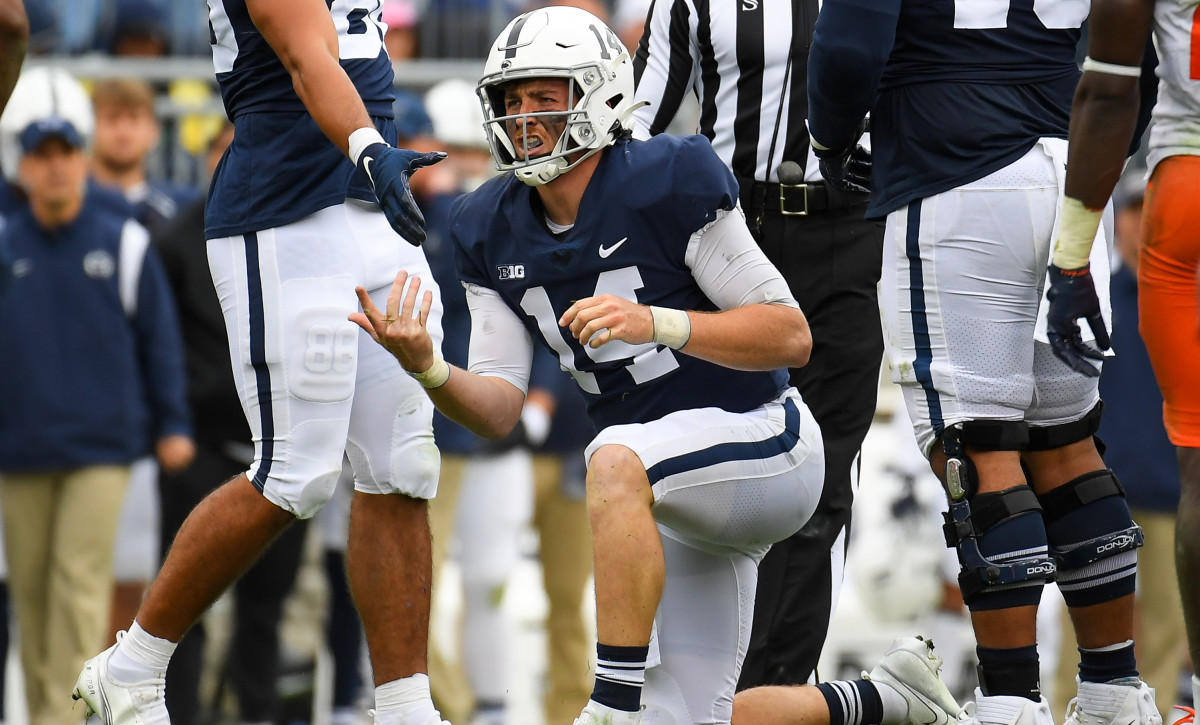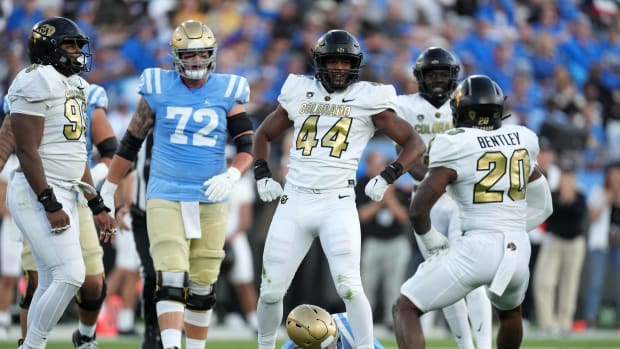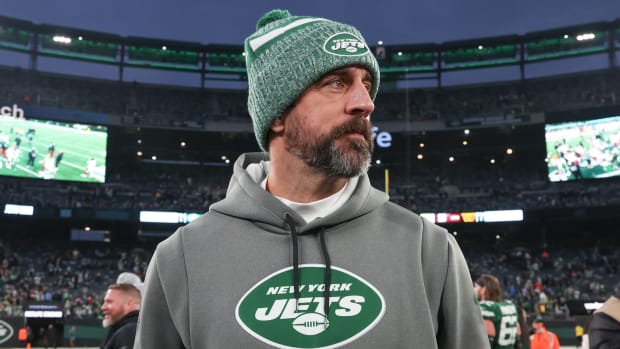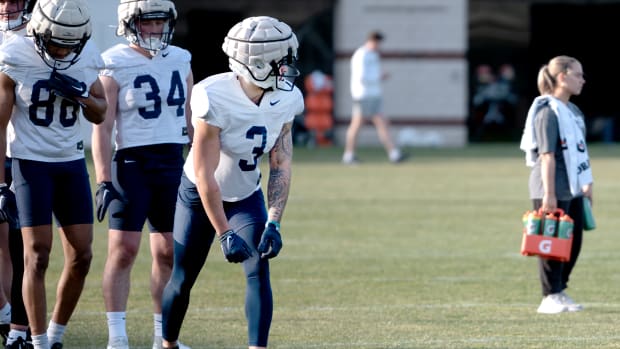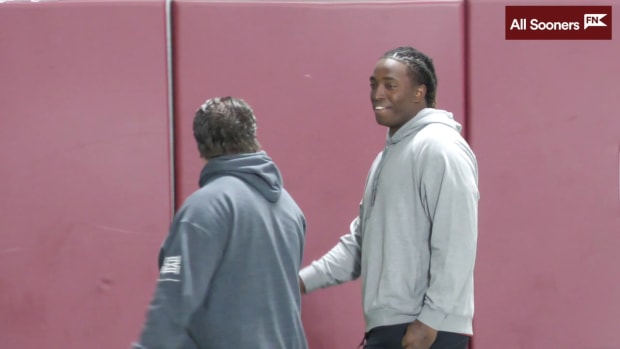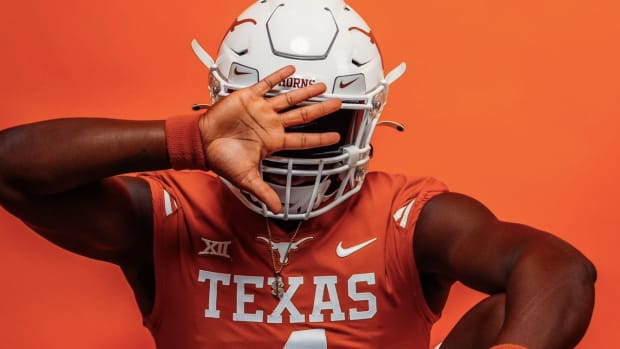Forde-Yard Dash: What Must Be Fixed in College Football
Forty names, games, teams and minutiae making news in college football, where remedial clock management lessons are available in Fort Collins.
MORE DASH: Upperclassmen Salutes | Big Ten East | Worst P5 Jobs
FIRST QUARTER: THE LATE-SEASON FIX-IT LIST
The Dash watched an abundance of games over the weekend, and amid the fun and excitement there were a number of things that appear broken and in need of repair. Some are quick fixes; others could require more elbow grease and ingenuity. The list:
Overtime (1). The new rules, which call for games to be decided on two-point conversion plays starting in the third OT, are terrible. As evidenced by the nine-OT festival of offensive ineptitude between Illinois and Penn State, a game that boils down to single-play possessions is a gimmick that strays from the fundamental cornerstone of the sport: four-play possessions, and all the strategy inherent to them.
The reason for the rule change was, as always, well-intentioned. Coaches and administrators are trying to protect players by limiting the number of plays—and, thus, the number of collisions and chances for injury, which increase as exhaustion sets in. Nobody wants a repeat of the LSU-Texas A&M seven-OT game of 2018, in which there were 197 snaps with every possession starting at the 25-yard line. But in downsizing all the way to the football version of soccer penalty kicks, the NCAA missed the sweet spot.
In many locales, high school overtime is simple and tidy: first and goal from the 10-yard line, with four downs to score or fail. That would yield fewer plays than possessions starting at the 25, while still maintaining a traditional possession length. Field goals are part of the equation, so the kicking game is not tossed aside as is the case with the two-pointer gimmick. If the concern is that it becomes too easy to score and/or make kicks, they could go to two-point plays after, say, the fifth OT. That’s theater of the absurd territory anyway.
Granted, few offenses are likely to be as persistently futile as Illinois and Penn State. They were a combined 3-for-14 in two-point attempts, a success rate of 21.4%. The national average is a 38.4% success rate—lower than The Dash expected, yet still far better than these two teams. (Never has three yards seemed so far as Saturday in Beaver Stadium.) Most games will end before getting to Dante’s Ninth Circle of Overtime Hell. But just in case, better OT rules could address snap-count concerns without turning games into one-play randomizers.
Penn State’s offense (2). A promising season has limped into the disappointment zone, and it could get worse from here. Since quarterback Sean Clifford went down with an injury against Iowa on Oct. 9, the Nittany Lions have scored 13 points in just less than seven full quarters of regulation play. They have three scoring drives in their last 22 regulation possessions, and one of those went only 23 yards after the Penn State defense produced a takeaway. And most importantly, they’re 0–2.
It’s a sobering commentary on the program’s quarterback depth when Clifford was the best option against Illinois while still obviously hurting two weeks after being injured against Iowa. An open date neither healed the senior nor elevated his backups to being game-ready, even when the opponent was 2–5 Illinois.
Of course, it would help if Penn State could run the ball even a little bit and force defenses to play them more honestly. Illinois held the Nittany Lions to 2.14 yards per carry, their lowest of the season. James Franklin couldn’t count on Clifford’s normal running ability—he had a career-worst minus-28 rushing yards—and the running back tandem of Noah Cain and Keyvone Lee couldn’t pick up the slack.
If Clifford doesn’t return to full health and spark the Penn State offense, good luck in upcoming games against Ohio State, Michigan and Michigan State.
Overly officious jerks (3). For whatever reason, the powers that be in both pro and college football have decided they want to crack down on taunting. Among those who made not of that renewed emphasis during the offseason was Big 12 coordinator of officials Greg Burks, who said at Big 12 media days, “It seems that every year we talk about unsportsmanlike conduct. It’s always an area that needs to be addressed. And what we are really going to be focusing on this year is taunting an opponent.”
Well, there is focusing on it and there is idiotically majoring in minors, which is what one official did during the Oklahoma State-Iowa State game. When Xavier Hutchinson of Iowa State was flagged for unsportsmanlike conduct while celebrating a long touchdown catch and run in extremely benign fashion, it might have been the worst flag of the season. (Or in NCAA history, according to the Iowa State radio team.) Fortunately for Hutchinson, he scored a couple of plays later.
This play should spur a recalibration of this crackdown, the reason for which hasn’t been explained very well to begin with. To college refs everywhere, as the stakes rise over the next month: please don’t decide games by throwing flags on minor celebrations. Lighten up, Francises.
Oklahoma’s ranking (4). After flailing past the worst Power 5 program in the country in Kansas, the pollsters may be (mildly and tardily) tiring of the Sooners’ underwhelming act. They dropped one spot to fourth in the AP Top 25 and two spots to fourth in the coaches’ poll. It still isn’t far enough. The Dash said in weeks past that they are inflated with blueblood helium, and they appear to have a large supply of it. Fact is, Oklahoma has beaten next-to-nobody, and done so unimpressively. Yet there they remain in the top five.
Oklahoma and Northern Illinois have the most one-score wins in the nation with five. The Sooners’ average margin of victory against FBS opponents is 8.9 points. Wake Forest, also undefeated, has an FBS average victory margin of 15.5 points against a slightly weaker schedule. There isn’t much daylight separating the two programs on paper, but there is in the polls: Oklahoma is nine spots higher than the Demon Deacons in both major polls.
What the College Football Playoff selection committee thinks of the Sooners will be extremely interesting and relevant to the rest of the season. We’ll get our initial read on that next week, along with another fascinating dilemma …
The Oregon-Ohio State rank order (5). The Ducks vaulted up three spots in the AP poll and are now only two behind the Buckeyes. They’re three spots behind in the coaches’ poll. That’s closer, but it remains perplexing how Oregon fell well behind a team with the same record that it beat on the road while missing its best player (rush end Kayvon Thibodeaux). In a vacuum, Oregon’s loss at Stanford is not a good one, but it came with significant mitigating circumstances: offensive coordinator Joe Moorhead made the trip but missed the game, undergoing an emergency surgical procedure while in the Bay Area; and the game was sent into overtime by a touchdown on an untimed down after a controversial interference call in the end zone.
Ohio State is the hottest team in the country after annihilating three Big Ten opponents in a row. But it still takes a willingness to ignore what happened head-to-head to rank them in front of Oregon.
Clemson (6). The Tigers’ streak of games against FBS competition in which they have failed to score 20 points in regulation has now reached six, three of them losses. That comes after a streak of 39 consecutive games scoring more than 20. Clemson’s offensive collapse has been a full-system failure, from chronic line issues to a suddenly pedestrian core of skill players to—most noticeably—abysmal quarterback play. DJ Uiagalelei was touted as a rising star but has crashed amid the weight of expectations and Dr. Pepper commercials. His 102.89 passing efficiency rating is by far the lowest of any starting quarterback in the Atlantic Coast Conference, and his two-interception, no-touchdown performance in the loss to Pittsburgh Saturday was the worst start of his career (a 75.01 rating).
Coach Dabo Swinney, he of the $90 million contract, rightfully took the blame after the game, saying it’s “100% on him.” But along with that he said there will be no staff changes, hinting at his inherent stubbornness. This season may prove to be an aberration and the Tigers rebound back to national prominence in 2022, but being a long shot to win the ACC Atlantic Division it has dominated for years would seem to merit a long look under the hood. A hard evaluation of the coaching staff and the quarterback position—five-star Cade Klubnik is coming, which means Uiagalelei will have competition—seem like the least Swinney can do.
FOUR FOR THE PLAYOFF
The Dash’s weekly look at how the playoff should shake out if today were Selection Sunday:
Orange Bowl: Top seed Georgia (7) vs. fourth seed Cincinnati (8).
The Bulldogs (7–0) had the week off, allowing Kirby Smart to scout Arch Manning in person in New Orleans. His team hasn’t showed even a flicker of complacency so far, and that shouldn’t change with rival Florida in front of it—not after the Gators housed Georgia last year in an upset romp.
Next up for Georgia: Florida in Jacksonville.
The Bearcats (7–0) endured some anxious moments against Navy on Saturday but emerged undefeated, stretching their regular-season winning streak to 15 games. Cincy’s stout run defense held up against the Midshipmen option, allowing just 2.87 yards per carry. The Cincinnati offense put up modest numbers, but much of that owed to running just 51 total plays while Navy monopolized the ball.
Next for Cincinnati: at Tulane.
Cotton Bowl: Second seed Michigan (9) vs. third seed Michigan State (10).
The Wolverines (7–0) pitched a 23–0 shutout in the second half to pull away from Northwestern. They lost their first two fumbles of the season, but counteracted that with two takeaways and also blocked a punt. One-two running back punch Blake Corum and Hassan Haskins each had 100-yard games—the fourth of the season for Corum and third for Haskins.
Next up for Michigan: at Michigan State.
The Spartans (7–0) had the week off to tune up for the showdown with in-state rival Michigan, a game that will likely identify who looms as the top threat to Ohio State in the Big Ten East. Michigan State had some work to do during the open week reinvigorating an offense that was held to just 241 yards and 3.89 yards per play at Indiana on Oct. 16.
Next up for Michigan State: Michigan in East Lansing.
Also considered: Oregon, Ohio State, Alabama.
MORE DASH: Upperclassmen Salutes | Big Ten East | Worst P5 Jobs
